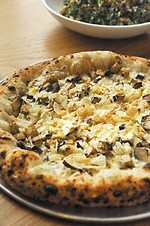Fajita History
By Virginia B. Wood, Fri., March 4, 2005

(Photo courtesy Falcon Family)
One of the most interesting facets of the American culinary revolution of the past 50 years is our growing fascination with culinary history. It seems the more we learn about the ethnic melting pot that makes up the American table, the more curious we become about regional cuisines and the origin of specific dishes. Texas is the proud home of an authentic regional cuisine, and the provenance of Tex-Mex foods is currently a very hot topic with everyone from academic researchers to cookbook authors to magazine and newspaper food writers. In exploring the history of fajitas, several credible stories emerge, and all of them have roots in the Rio Grande Valley of Texas. It only makes sense that several people from the same ethnic group with roots in the same geographic area would come up with similar cooking techniques and names for the raw materials at hand.
The first serious study of the history of fajitas was done in 1984 by Homero Recio as part of his graduate work in animal science at Texas A&M. Recio was intrigued by a spike in the retail price of skirt steak, and that sparked his research into the dish that took the once humble skirt steak from throwaway cut to menu star. Recio found anecdotal evidence describing the cut of meat, the cooking style (directly on a campfire or on a grill), and the Spanish nickname going back as far as the 1930s in the ranch lands of South and West Texas. During cattle roundups, beef were butchered regularly to feed the hands. Throwaway items such as the hide, the head, the entrails, and meat trimmings such as skirt were given to the Mexican vaqueros (cowboys) as part of their pay. Hearty border dishes like barbacoa de cabeza (head barbecue), menudo (tripe stew), and fajitas/arracheras (grilled skirt steak) have their roots in this practice. Fifth-generation McAllen rancher and cookbook author Melissa Guerra heard very similar stories in researching her first cookbook, The Texas Provincial Kitchen, and her upcoming work, Dishes of the Wild Horse Desert. Considering the limited number of skirts per carcass and the fact the meat wasn't available commercially, the fajita tradition remained regional and relatively obscure for many years, probably only familiar to vaqueros, butchers, and their families.
Fajitas appear to have made the quantum leap from campfire and backyard grill obscurity to commercial sales in 1969. Sonny Falcon, an Austin meat market manager, operated the first commercial fajita taco concession stand at a rural Dies Y Seis celebration in tiny Kyle in September of 1969. That same year, fajitas debuted on the menu at Otilia Garza's Round-Up Restaurant in the Rio Grande Valley community of Pharr, according to Texas Monthly contributing editor John Morthland in a 1993 magazine story. Morthland writes that Garza never claimed to have invented the dish, but she did maintain a tradition of grilling skirt steak learned from her grandmother, a restaurateur in Reynosa, Mexico. At the Round-Up, fajitas were served on a sizzling platter with warm flour tortillas and mounds of condiments – guacamole, pico de gallo (chopped fresh onions, tomatoes, peppers, and cilantro), and grated cheese – for making tacos. In the Mexican ranching states that share a border with Texas, a similar dish called arracheras (grilled fillets of skirt steak) has been served for decades, according to cookbook authors Cheryl and Bill Jamison in The Border Cookbook.
We pick up the fajita trail in Houston in 1973, when a Rio Grande Valley native named Ninfa Rodriguez Laurenzo opened a Tex-Mex restaurant on Navigation Boulevard called Ninfa's. She built a restaurant empire on a good bar business and the simple, tasty foods of her Valley heritage, including fajitas, sold as "tacos al carbon" and "tacos a la Ninfa." While Tex-Mex restaurateurs such as Otilia Garza and Ninfa Laurenzo were popularizing fajitas in Houston and the Valley during the 1970s, Sonny Falcon was introducing them to thousands of Anglos and Hispanics alike at his concession stands at rodeos, outdoor fairs, and festivals all over the state.
Perhaps the most unlikely character to spread fajita fame (and blur the real meaning of the word) was German-born chef George Weidmann. Weidmann was the opening chef of the Hyatt Regency in Austin in 1982, and it wasn't long before he recognized the commercial potential of a popular local Tex-Mex dish. The canny chef put "sizzling fajitas" on the menu of the Hyatt's La Vista restaurant, and soon sales of that signature dish made it the most profitable restaurant in the Hyatt chain. Weidmann spent the last 20 years of his career at the Austin Hyatt and was often called upon to travel to other properties to share his fajita secrets (he used the more tender sirloin) with other chefs in the chain. Fajitas remain a Hyatt menu mainstay to this day.
That brings us to the great irony of fajita success: The more popular the dish became, the less likely it was to be made from skirt steak at all. By the mid-1980s, fajitas were a fairly common dish in most Mexican restaurants and would ultimately become a popular Nineties fast-food item, thanks to Jack in the Box and Taco Bell. Increased demand often led Mexican restaurant operators to substitute other cuts of meat, and the addition of grilled items such as chicken, shrimp, and even vegetable "fajitas" blurred the line even further.








